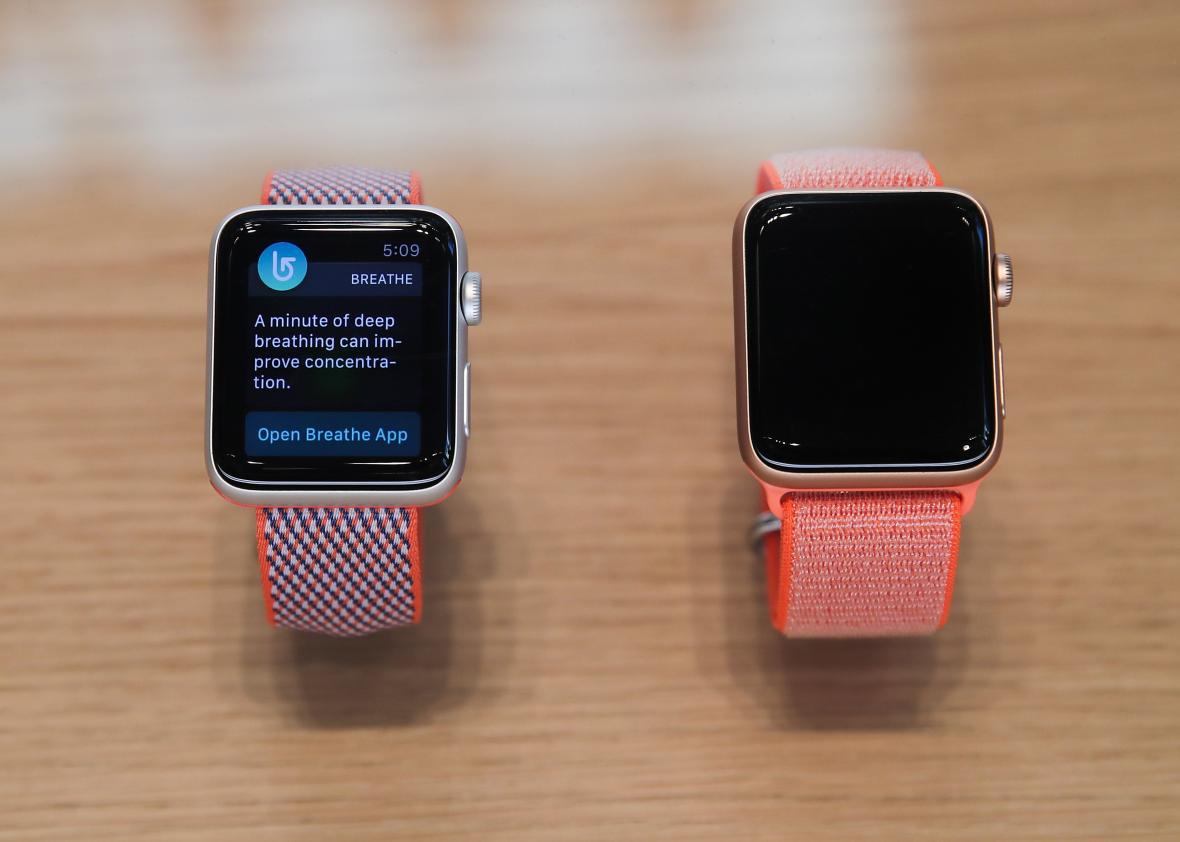Apple may be taking steps to transform its flagship wearable into a true medical device. According to Bloomberg, Apple is working on a built-in electrocardiogram (EKG) feature that could help Apple Watch wearers better identify developing heart conditions without needing to spend time at the doctor’s office.
Apple’s reported method for the EKG—a test of the heart’s electrical activity—is straightforward. It would require the wearer to squeeze the outer edge of the Apple Watch with his opposite hand, at which point the device would send a minute electrical current through his hand and across his chest to measure the electrical signals in his heart. With this technique, the Watch would be able to detect heartbeat patterns, including abnormal conditions like arrhythmia. Between this capability and the Apple Watch’s continual heart-rate tracking in the background, wearers—particularly those with or at risk for heart conditions—could get a clearer picture of their heart health and activity.
It’s a bold move on the part of the consumer-focused electronics maker. Many had surmised that Apple wouldn’t enter the medical device space because of the lengthy and rigorous FDA approval process required. Instead, Apple could rely on third-party specialists to handle that task—something that’s already started to happen. AliveCor’s Kardiaband, an Apple Watch band with a built-in EKG reader, recently became the first FDA-cleared medical accessory for the Apple Watch. The Kardiaband monitors your heart continuously whenever you press a finger to its onboard sensor, somewhat similar to Apple’s proposed technique. While the Kardiaband is the only medical-grade Apple Watch accessory available, the iPhone has a robust medical accessory market ranging from glucose meters to blood pressure monitors to ultrasound imaging devices. With a few more years, it’s quite likely that the Apple Watch will have a suite of third-party medical companions, transforming its utility with little effort on Apple’s end.
While it makes sense for Apple to expand its watch’s heart-rate tracking capabilities, an EKG reader is niche—as UCSF cardiologist Ethan Weiss told Bloomberg, it’s not something you need unless you’re experiencing issues such as fainting spells or heart palpitations. If you’re purchasing the device for an older relative, it’s a feature that could be convenient to have. EKG reading is also a nice feature to include if Apple continues its trend of working with leading researchers on programs such as the Apple Heart Study. Whether you’re a healthy individual or experience irregular heart rhythms, organizations like Stanford Medicine (which Apple partnered with on this study) can use that data to inform their research, learn more about how our hearts work, and then better diagnose, treat, and prevent heart-related health issues in the future.
Over the past few years, Apple has been augmenting the Apple Watch’s core functionality with a number of increasingly useful features. In the fitness realm, after adding features like greater water resistance, GPS location tracking, and a barometric altimeter for elevation tracking, Apple recently began rolling out the ability for its watch to connect directly with gym equipment. With this capability, watch wearers can better track their indoor workouts, while with GPS and the altimeter, you can more accurately record outdoor workouts. And with Apple Health integration, you can record or share data to a variety of different apps, too.
In terms of general convenience, the addition of cellular connectivity in the Apple Watch Series 3 was also a big improvement: It meant that you could stream data or make phone calls without your phone on-hand. And perhaps that’s part of the endgame with developing a capability like an EKG heart monitor: The company is working towards making the Apple Watch a fully featured device that stands on its own, without the aid of an iPhone or third-party accessories.
As with all things in development at Apple, there’s no guarantee the company will ever follow this reported project to fruition. However, it does align with the company’s growing interest in the health and heart health space. It would also continue to build out Apple’s wearable as an independent device, making it a more convincing sell to those who have yet to purchase one. The Apple Watch becomes a productivity, fitness, and health powerhouse, capable of performing in each of those areas with accuracy and an unparalleled ease of use.
On top of that, the health industry is an especially lucrative market to get into—and Apple’s all about that, too.
